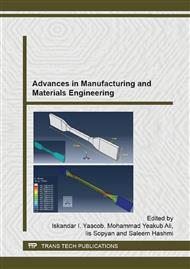p.573
p.578
p.585
p.589
p.596
p.601
p.606
p.610
p.616
Painting Process Improvement through Six Sigma Approach in a Malaysian Vehicle Assembly Company
Abstract:
Painting is an important process in the automotive assembly to give more attractive appearance to the vehicles and to provide the layer of protection against corrosion and weathering. The objective of this paper is to identify and analyze the factors affecting the quality of painting process at Company RST’s Paint Shop. The paint shop was unable to perform the painting process satisfactorily and deliver the painted vehicle bodies as per customer specifications. The study concentrated on the fiber defect detected at Top Coat Area as the major problem of paint deficiency. Using activities like Genba investigation, data collection, trials and data analysis, the root causes of the problem were identified. Six Sigma DMAIC approach was utilized in conducting the improvement activities. Through designed experiments conducted to determine the best parameter setting of the spray gun used in the painting process, it was found that 3.5 bars for air pressure and 450 ml/minutes for fluid delivery resulted in the lowest paint defect. The use of Six Sigma DMAIC approach had succeeded in helping the company to minimize paint fiber defect per unit (DPU) from 10 to less than 3 DPU. The results from the study have provided an insight on successful deployment of DMAIC through application of its various statistical tools and techniques, and as the systematic problem-solving framework on solving actual industrial issues such as automotive painting problem.
Info:
Periodical:
Pages:
596-600
Citation:
Online since:
July 2015
Authors:
Keywords:
Price:
Сopyright:
© 2015 Trans Tech Publications Ltd. All Rights Reserved
Share:
Citation:


